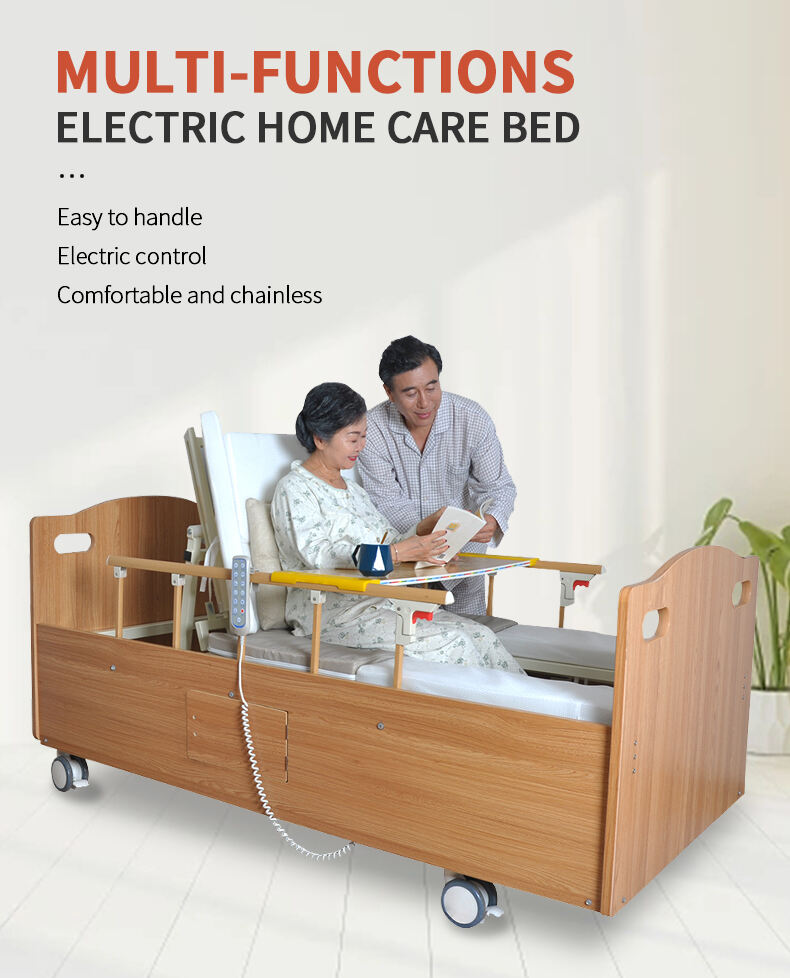Viktiga överväganden för medicinska sängar i hemmet
Miljö, blir valet av rätt säng för hemvård ett avgörande steg som påverkar både patients komfort och vårdgivarens effektivitet. En hem miljö, blir valet av rätt säng för hemvård ett avgörande steg som påverkar både patients komfort och vårdgivarens effektivitet. En hemvårdsbed utgör centrum för hemvård och ger inte bara en plats att vila på, utan också en specialiserad medicinsk utrustning som främjar läkning, förebygger komplikationer och förbättrar livskvaliteten. Att fatta ett välgrundat beslut kräver förståelse för de olika funktionerna, alternativen och överväganden som är relevanta.
Marknaden erbjuder många olika alternativ för hemvårdsängar, var och en designad för att möta specifika behov och medicinska tillstånd. Från enkla manuella modeller till sofistikerade elektroniska versioner kräver urvalsprocessen noggrann uppmärksamhet på detaljer som kommer att påverka daglig användning. Den här omfattande guiden går igenom de viktigaste funktionerna och övervägandena för att hjälpa dig att göra det bästa valet för din specifika situation.
Kärnfunktioner hos kvalitets hemvårdsängar
Justerbarhet och positioneringsalternativ
Moderna vårdsängar för hemmet är utrustade med olika justeringsfunktioner som avsevärt påverkar patientens komfort och vårdkvalitén. Den mest grundläggande funktionen är möjligheten att justera huvud- och fotänden separat. Denna flexibilitet gör det möjligt att välja bland många positioner, från en plan position för sömn till upphöjd huvuddel för läsning eller matintag, samt upphöjd fotända för förbättrad cirkulation.
Avancerade modeller av hemvårdsängar erbjuder ytterligare ledpunkter, vilket möjliggör mer exakta positioneringar och komfortjusteringar. Vissa sängar har Trendelenburg- och omvänd Trendelenburg-position, vilket kan vara avgörande vid vissa medicinska tillstånd. Möjligheten att justera sängens höjd är en annan viktig funktion, vilket underlättar för vårdpersonal att utföra vård utan att belasta ryggen och gör det säkrare för patienter att flytta in och ut ur sängen.
Säkerhetsfunktioner och sängbarriärsystem
Säkerhet är fortfarande det viktigaste vid val av säng för hemvård. Sideskydd har flera funktioner, från att förhindra fall till att hjälpa till vid ompositionering. Moderna sängar erbjuder olika konfigurationer av sideskydd, från hel- till halvlängdsmodeller, och vissa har delade skydd som kan sänkas eller höjas oberoende av varandra. De bästa hemvårdssängarna har smidiga och säkra låsmechanismer för dessa skydd, vilket säkerställer att de förblir fastlåsta på plats när de används.
Ytterligare säkerhetsfunktioner kan inkludera nödströmsbatteribackupsystem, vilket säkerställer att sängen förblir funktionsduglig vid strömavbrott. Hörnbeslag och hjullås förhindrar oönskad rörelse och skyddar både sängen och omgivande väggar från skador. Vissa modeller innehåller även inbyggda sängutgångslarm, vilket ger en extra säkerhetsnivå för patienter med risk för fall.

Viktkapacitet och överväganden gällande hållbarhet
Maximal viktkapacitet
Att förstå viktkapaciteten är avgörande vid val av säng för hemvård. Standardmodeller klarar vanligtvis mellan 350 och 450 pund, medan baritriska modeller kan hantera upp till 1000 pund eller mer. Det är viktigt att välja en säng med en viktkapacitet långt över patientens nuvarande vikt för att säkerställa långsiktig funktionalitet och säkerhet. Denna extra kapacitet tar hänsyn till ytterligare vikt från medicinsk utrustning, lakan och krafter som uppstår vid rörelse eller ompositionering.
Viktkapaciteten påverkar inte bara sängens ram utan också motorsystemets slitstyrka i elektroniska modeller. Sängar med högre klassificering har ofta förstärkta ramar och kraftfullare motorer, vilket säkerställer smidig drift under större belastningar. När du bedömer viktkapaciteten bör du ta hänsyn till inte bara omedelbara behov utan även potentiella framtida krav.
Ramkonstruktion och material
Konstruktionskvaliteten på en hemvårdsäng påverkar direkt dess livslängd och prestanda. Premiummodeller har vanligtvis stålramar med slitstarka pulverlackerade ytor som motstår repor och korrosion. Vissa tillverkare använder flygplansbaserat aluminium i vissa komponenter, vilket ger en optimal balans mellan hållfasthet och vikt. Kvaliteten på svetsförband, hörnfogar och sammanbyggnad påverkar i hög grad sängens stabilitet och livslängd.
Materialval sträcker sig bortom ramen till konstruktionen av bädden, som kan vara i nät, solid platta eller gitterdesign. Varje alternativ erbjuder olika fördelar när det gäller madrassstöd, luftcirkulation och rengöring. Högkvalitativa material och konstruktioner kräver ofta högre pris, men visar sig ofta mer ekonomiska på lång sikt tack vare minskade underhållsbehov och längre användningstid.
Elektronik och kontrollsystem
Alternativ för kontrollgränssnitt
Moderna vårdsängar erbjuder olika kontrollmekanismer för att passa olika användarkompetenser. Handhållna hängslen är fortfarande de vanligaste och har stora, tydligt markerade knappar för enkel hantering. Vissa avancerade modeller inkluderar trådlösa fjärrkontroller eller integrering med smartphones, vilket ger större flexibilitet vid sängjustering. De bästa systemen erbjuder intuitiva kontroller med tydlig återkoppling, så att användare lätt kan uppnå önskade positioner.
Kontrollpaneler kan också innehålla minnesfunktioner för att spara ofta använda positioner, vilket minskar behovet av upprepade justeringar. För patienter med begränsad rörlighet eller styrka kan beröringskänsliga kontroller eller röstaktiverade system vara tillgängliga. Placeringen av kontrollgränssnitten bör vara lättillgänglig både för patienten och vårdpersonal.
Motorsystem och strömförutsättningar
Kvaliteten på motorerna i en vård säng påverkar direkt dess prestanda och tillförlitlighet. Modeller i högsegmentet har vanligtvis flera motorer som styr olika funktioner, och de arbetar tyst och smidigt. Dessa system bör innehålla termisk skydd för att förhindra överhettning samt erbjuda manuell justering vid strömavbrott.
Effektförbrukningen varierar mellan olika modeller av vård sängar, där vissa kräver dedikerade kretsar för optimal prestanda. Moderna sängar innehåller ofta energieffektiva motorer och kan ha batteribackupsystem för oavbruten drift vid strömavbrott. Att förstå de elektriska kraven och ha lämplig elinfrastruktur är avgörande för tillförlitlig drift.
Vanliga frågor
Vad är den typiska livslängden för en vård säng?
En kvalitets säng för hemvård håller vanligtvis 8–10 år vid regelbunden användning, förutsatt att den sköts ordentligt. Detta kan dock variera avsevärt beroende på användningsmönster, utnyttjande av viktkapaciteten och underhållsrutiner. Modeller i högre prisklass med bättre konstruktion och material kan hålla ännu längre, eventuellt upp till 15 år.
Hur ofta bör underhåll av sängar för hemvård utföras?
Regelbundet underhåll bör utföras minst kvartalsvis, inklusive kontroll av alla rörliga delar, åtdragning av skruvar, smörjning av leder och test av elektroniska funktioner. Månatliga säkerhetskontroller av sängkantsskydd, bromsar och nödfunktioner rekommenderas. Professionell service bör planeras in årligen, eller oftare för tungt använda sängar.
Kan vanliga madrasser användas på sängar för hemvård?
Standardmässiga hushållsmattor rekommenderas inte för vårdsbäddar eftersom de kanske inte anpassar sig ordentligt till sängens rörliga delar och kan påverka sängens säkerhetsfunktioner. Särskilda medicinska madrasser som är utformade för vårdsbäddar bör användas för att säkerställa korrekt funktion och patientkomfort samt bibehålla terapeutiska fördelar.


